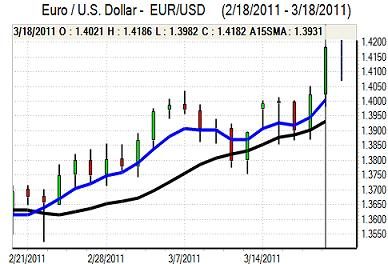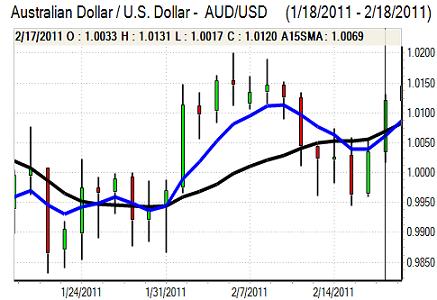EUR/USD
The Euro continued to probe resistance levels above 1.4070 against the dollar during Friday and a break higher triggered a move to a fresh 2011 peak above 1.4180 before consolidation with the US currency also testing 2010 lows on a trade-weighted basis.
Market activity tended to be dominated by G7 intervention to weaken the Japanese yen and degrees of safe-haven asset demand as events in Libya were monitored closely, especially as there were no major economic data releases during the day. The announcement of a cease-fire by the Libyan government following United Nations-led action against military infrastructure had some impact in improving risk appetite and also dampened any defensive dollar demand.
Statements from ECB officials remained under close scrutiny to assess whether recent global events will lead to a reassessment of monetary policy. In comments on Friday, bank President Trichet stated that strong vigilance was still needed on inflation and that he had no new message for the markets. These comments clearly indicated that the bank remained on track at this stage to raise interest rates at the April council meeting. In later comments, Trichet also stated that the bank would think deeply about the Japanese situation which suggests that a policy change is still a possibility and comments will continue to be watched very closely in the short term.
The dollar remained hampered by speculation that the Federal Reserve would maintain a highly expansionary monetary policy over the next few months. The Euro edged slightly weaker in Asian trading on Monday, but remained above the 1.4150 level.

Source: VantagePoint Intermarket Analysis Software
Call now and you will be provided with FREE recent forecasts
that are up to 86% accurate * 800-732-5407
If you would rather have the recent forecasts sent to you, please go here
Yen
Yen volatility inevitably remained extremely high on Friday following confirmation that G7 members had intervened directly in the currency markets for the first time since Autumn 2000. The dollar peaked just below 82 following the yen’s biggest decline for over six months, but the US currency was then generally weaker during the European and US sessions with a test of support below 80.80.
Market estimates suggested intervention amounts were in excess of US$25bn which suggested that G7 was certainly serious in its intentions. There was still an active debate whether intervention was designed to prevent disorderly conditions or whether it was aimed at specifically weakening the Japanese currency.
There were further expectations of capital repatriation by Japanese companies over the next few weeks which maintained underlying demand for the yen. From a longer-term perspective, there were fears that the Japanese budget situation would deteriorate even more substantially while there will also be an important negative impact on exports which would curb direct yen demand.
Japanese markets were officially closed for a holiday on Monday which stifled activity to some extent and the dollar consolidated above 80.50 with no immediate evidence of further intervention.
Sterling
Sterling found support close to 1.6060 against the US dollar during Friday and advanced strongly to a peak near 1.6250 as the US currency was firmly on the defensive. Sterling remained weaker against the Euro and tested support beyond 0.8750 for the first time since early November.
Following much weaker than expected consumer confidence data, market sentiment towards the economy was generally weaker with speculation that the government would downgrade its GDP growth forecasts in this week’s budget and the latest mortgage approvals data also remained weak.
If the government maintains its stance towards raising taxes in the fiscal statement, there will also be expectations that the Bank of England will be extremely cautious over raising interest rates. In comments on Friday MPC member Bean stated that it was best to wait and assess economic developments which again suggested that the bank will take a wait and see approach.
Sterling held above 1.62 against the dollar in Asian trading on Monday as US weakness persisted.
Swiss franc
The dollar was capped near 0.9050 against the franc during Friday and dipped to test support below 0.90 before regaining some ground. The US currency was protected to some extent by a weaker franc tone on the crosses as the Euro gained ground. Technically, there was some speculation that a medium-term double bottom in the Euro/franc pair may have been seen below 1.25.
Safe-haven considerations remained extremely important for the franc and an easing of immediate fears surrounding the Japanese nuclear facility, allied with a cease-fire announcement in Libya, had an impact in lessening defensive demand for the Swiss currency. Underlying confidence remains very fragile and volatility is likely to remain a key market feature.

Source: VantagePoint Intermarket Analysis Software
Call now and you will be provided with FREE recent forecasts
that are up to 86% accurate * 800-732-5407
If you would rather have the recent forecasts sent to you, please go here
Australian dollar
The Australian dollar was capped near the 0.9950 resistance level against the US dollar for much of the European session on Friday, but it retained a solid tone and moved above parity during the Asian session on Monday as volatility remained high.
The currency drew support was a generally fragile US currency and by an improvement in risk appetite as market confidence looked to stabilise following the sharp equity market declines earlier in the week.
There was still caution over commodity-price trends as Japanese industrial production faltered which dampened aggressive demand for the Australian currency.



